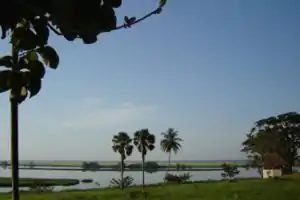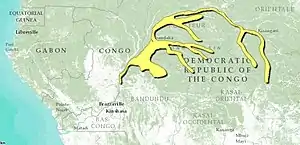Eastern Congolian swamp forests
The Eastern Congolian swamp forests are a fairly intact but underresearched ecoregion of the tropical and subtropical moist broadleaf forests biome. It is located within the Democratic Republic of the Congo. This is the eastern half of one of the largest areas of swamps in the world.
| Eastern Congolian swamp forests | |
|---|---|
 Tumba-Ngiri-Maindombe, the largest RAMSAR wetland in the world | |
 Map of the Eastern Congolian swamp forests | |
| Ecology | |
| Realm | Afrotropical |
| Biome | Tropical and subtropical moist broadleaf forests |
| Borders | |
| Geography | |
| Area | 92,315 km2 (35,643 sq mi) |
| Country | Democratic Republic of the Congo |
| Conservation | |
| Conservation status | relatively stable |
| Protected | 23,092 km² (25%)[1] |
Setting
The swamp forest is flat, wet forest between 300–400 metres (980–1,310 ft) in elevation on the left bank of the River Congo, and spreading across a swathe of the Congo Basin, including some of the Congo's largest tributaries and the Stanley Falls area near Kisangani.[2]
Flora
The forest is a mixture of habitats including wetlands and swamps, with drier forest and savanna slightly higher and flooded seasonally by the Congo and its tributaries.
Fauna
The region has been insufficiently researched by zoologists but is known to be home to forest elephants (Loxodonta africana cyclotis) (which may have been reduced by poaching, especially near the larger rivers), and several primates, including the rare bonobo (Pan paniscus). The Congo is a natural barrier to movement of wildlife and many species only occur on this eastern side of the river, including many primates: the bonobo and also Angolan colobus (Colobus angolensis), Wolf's mona monkey (Cercopithecus wolfi), golden-bellied mangabey (Cercocebus galeritus chrysogaster), black mangabey (Lophocebus atterimus aterrimus), southern talapoin (Miopithecus talapoin) and the Dryas monkey (Cercopithecus dryas).
Near-endemic mammals include Hutterer's brush-furred mouse (Lophuromys huttereri), Allen's striped bat (Chalinolobus alboguttatus), and Muton's soft-furred mouse (Praomys mutoni).
These rainforests are rich in birdlife including the Congo sunbird (Cinnyris congensis), African river martin (Pseudochelidon eurystomina) and Congo martin (Riparia congica).
Endemic amphibians and reptiles include a small frog (Cryptothylax minutus), Chapin's chameleon (Trioceros chapini), a wall lizard (Gastropholis tropidopholis), the Zaire snake-eater (Polemon robustus), and a worm lizard (Zygaspis dolichomenta).
Threats and conservation
The Congo River allows access to these forests with subsequent logging and poaching of wildlife, particularly of forest elephants.
Protected areas include the huge Salonga National Park, and the Réserve Naturelle Lomako Yokokala.
See also
- Congolian forests
- Flora of West-Central Tropical Africa
References
- Eric Dinerstein, David Olson, et al. (2017). An Ecoregion-Based Approach to Protecting Half the Terrestrial Realm, BioScience, Volume 67, Issue 6, June 2017, Pages 534–545; Supplemental material 2 table S1b.
- "Eastern Congolian swamp forests". Terrestrial Ecoregions. World Wildlife Fund.
External links
- "Eastern Congolian swamp forests". Terrestrial Ecoregions. World Wildlife Fund.
- Eoearth.org: Salonga National Park
- Plexusowls.com: Detailed study of Salonga National Park
- Zoosociety.org: Bonobo conservation in Salonga National Park
- Eastern Congolian Swamp Forests. Bioregions 2020. One Earth.
